Taxi advertising puts your brand in front of people. These moving billboards drive through high streets, business zones, and tourist hotspots, making sure your message gets seen where it counts. It’s not background noise. It’s front and centre. With the reach of outdoor media and the motion of mobile advertising, taxi ads turn everyday journeys into constant brand exposure.
What is Taxi Advertising?

A taxi advert refers to any promotional display placed on or inside a taxi. This can include full-body wraps, rooftop signs, rear panels, or branded interiors. These ads are seen by thousands of people every day, whether on the road, at traffic signals, or waiting at busy junctions.
Unlike static billboards, taxi ads move through the city, covering a wide range of locations and reaching diverse audiences throughout the day. The concept of taxi advertising has evolved over the past century. It first gained traction in global cities like New York and London, where taxis were already a part of everyday life.
As urban centers expanded and traffic volumes grew, advertisers recognized the value of placing their messages on vehicles that were constantly in motion. What started with simple painted signs has grown into bold, creative campaigns that use modern printing technology and smart targeting strategies.
In a city like London, the impact of taxi advertising is especially strong. The iconic London taxi cab is instantly recognizable and holds cultural and commercial value. These cabs navigate busy high streets, tourist attractions, corporate zones, and residential neighborhoods. With such constant movement and visibility, advertising in London through taxis allows brands to achieve wide coverage without being confined to a single location.
Why Taxi Advertising Still Works in 2025?
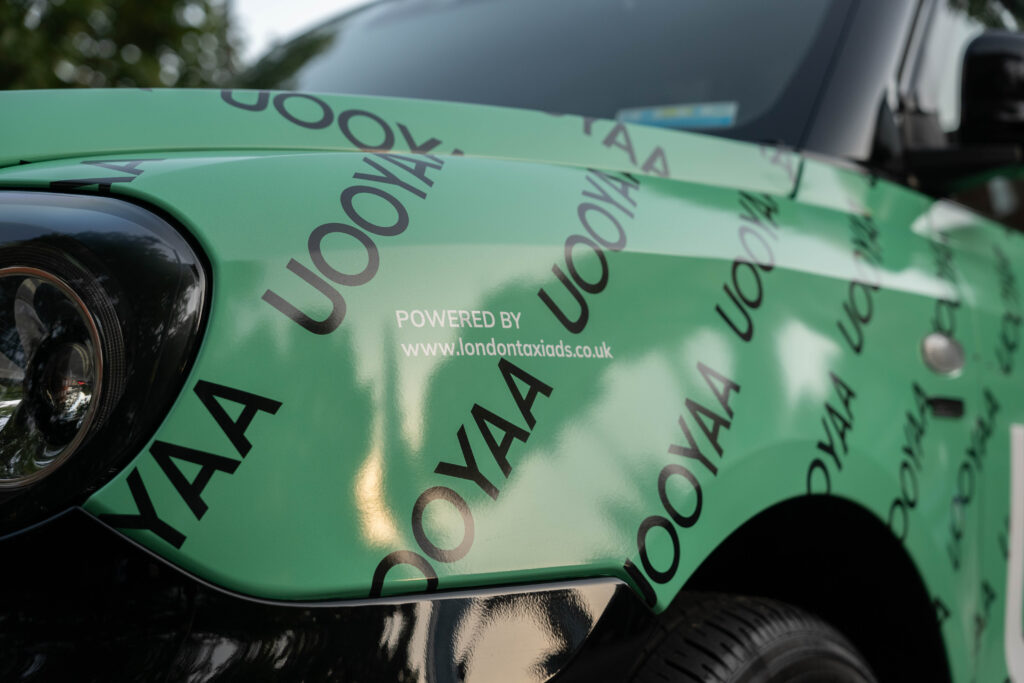
1. Trusted Format in a Distracted World
Taxi advertising continues to thrive in 2025 because it taps into a format people instinctively trust. In cities like London, the black cab is more than a transport vehicle. It’s a cultural icon that represents safety, authority, and reliability. When a brand appears on a London taxi, it inherits this credibility. Consumers are more likely to trust messaging placed on a taxi than on a random online pop-up.
2. Digital Fatigue Is Real
The average person is exposed to over 10,000 digital ads a day. This leads to ad fatigue, where users begin to tune out or actively avoid online content. Taxi advertising breaks through this wall of noise. It delivers a brand message in the physical world, where attention is more focused. Seeing a taxi advert on the road or at a busy junction feels natural and non-intrusive.
3. Real-World Presence Drives Higher Recall
Taxis are always moving across high-footfall zones, including shopping areas, business districts, and tourist landmarks. This constant motion maximises brand exposure without needing a user to click, scroll, or log in. Studies have shown that physical ads like taxi signage lead to stronger memory retention. One report revealed that over 70% of people remembered brands they saw on a taxi in a major city.
4. High ROI Compared to Digital
Taxi advertising ROI is increasingly attractive to marketers. Unlike digital ads that disappear after a scroll, a branded taxi provides continuous visibility for weeks or even months. It works day and night, across neighbourhoods, and in front of real people. The cost per thousand impressions (CPM) is often lower than most digital formats, especially when targeting urban areas.
5. It Works Especially Well in London
When it comes to advertising platforms in London, taxis stand out due to their constant circulation and broad demographic reach. Whether parked near Oxford Street, moving through Canary Wharf, or waiting outside Heathrow, a London taxi cab gives your brand unmatched local exposure. No other moving format offers this combination of trust, movement, and memorability.
6. Tangible Value in a Digital Economy
The impact of taxi advertising on consumers is rooted in its physicality. In a world where digital ads can be skipped, blocked, or ignored, taxi ads cannot be turned off. They’re part of the streets, part of the culture, and part of everyday life in a busy city. This tangible presence reinforces brand recall and increases the chances of offline and online engagement.
Types of Taxi Advertising Formats
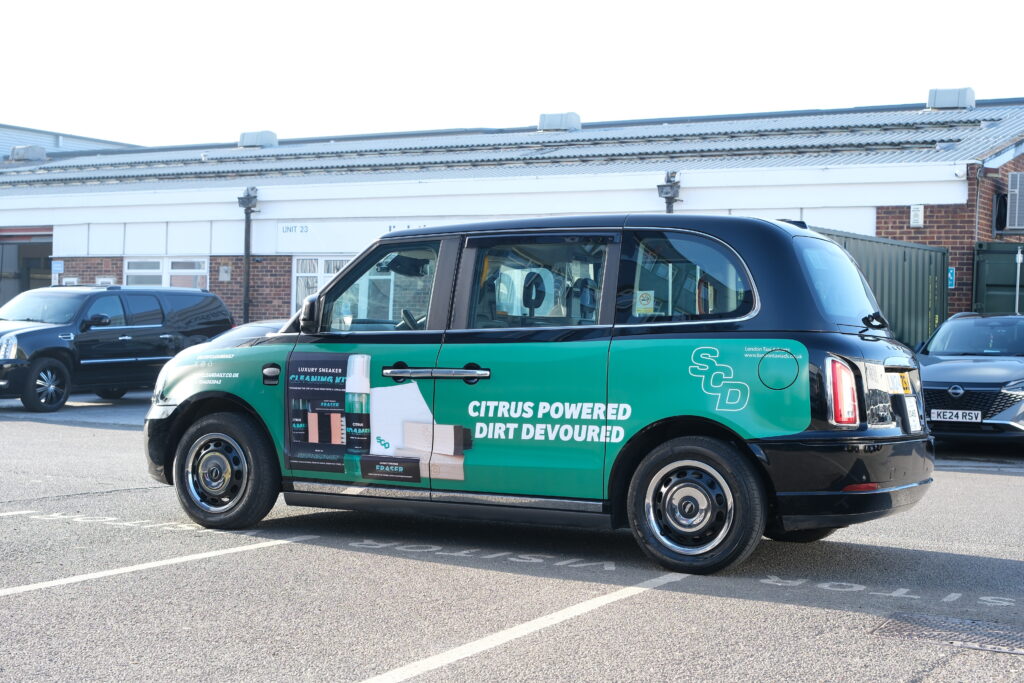
Taxi advertising is far from one-size-fits-all. Brands can choose from a range of formats depending on budget, campaign goals, and the kind of impact they want to make. From bold, full-body wraps to subtle interior placements, each type has its own advantage in terms of visibility and engagement.
1. Full Wrap Advertising
A full taxi wrap covers the entire exterior of a cab with branded visuals. This includes the sides, rear, bonnet, and sometimes even the roof. It turns the vehicle into a moving billboard and delivers maximum visibility on the streets of London.
- Full wraps are ideal for bold, high-impact campaigns.
- These wraps work best for product launches, rebrands, or major awareness drives.
- In high-traffic zones like central London, taxi wrap advertising with full coverage makes a strong visual statement that’s hard to miss.
Brands often use printed taxi wraps from London agencies to design and apply high-quality vinyl graphics that can withstand weather and long-term use. When done well, a full wrap can create an immersive brand experience that travels across boroughs, day and night.
2. Partial Wrap / Superside Panels
If you’re looking for a more budget-friendly but still effective option, partial wraps or superside panels are a great choice.
- These usually cover just the side doors or a large horizontal panel across the body of the cab.
- They offer strong visibility while leaving parts of the original taxi design exposed.
- Partial wraps still benefit from high footfall but at a lower cost compared to full wraps.
This format is often chosen for ongoing, medium-term campaigns or for brands that want to test the effectiveness of taxi wrap advertising before committing to a full wrap strategy.
3. Taxi Top Advertising (Static and Digital)
Taxi top formats involve a display box or digital screen mounted on the roof of the cab.
- Static tops use traditional lightbox displays with printed creatives.
- Digital taxi tops use LED screens to showcase animated or rotating ads.
This high-up placement is particularly visible in traffic and busy pedestrian zones. Digital screens can rotate between multiple ads or change depending on location or time of day, offering flexibility through programmatic ads. This format is great for advertisers looking to target peak commuting hours or for brands promoting events, time-sensitive offers, or dynamic content.
4. Interior / Tip-Seat Advertising
Interior taxi advertising places branded content inside the cab, usually on the back of the driver and passenger seats (commonly called tip-seat ads), side panels, or window stickers.
- Captures the attention of seated passengers during the ride.
- Useful for detailed messaging, QR codes, app downloads, or short brand stories.
- Allows for direct engagement, especially on longer rides across the city.
Interior formats work well when paired with exterior creative taxi wraps for a cohesive branding experience, both inside and out.
5. Digital Screens and Programmatic Ads
Some London taxis are now fitted with digital screens inside the cabin or on top of the vehicle. These are connected to programmatic advertising systems that can serve targeted content in real time.
- Ads can change based on location, weather, time, or even nearby events.
- Campaigns can be updated remotely without reprinting materials.
- Offers granular reporting and analytics, helping track engagement and impressions.
These modern formats are bridging the gap between traditional taxi wrap advertising and digital marketing strategies, offering brands the best of both worlds — real-world presence with data-driven delivery.
Taxi Advertising in London – The Premier Market
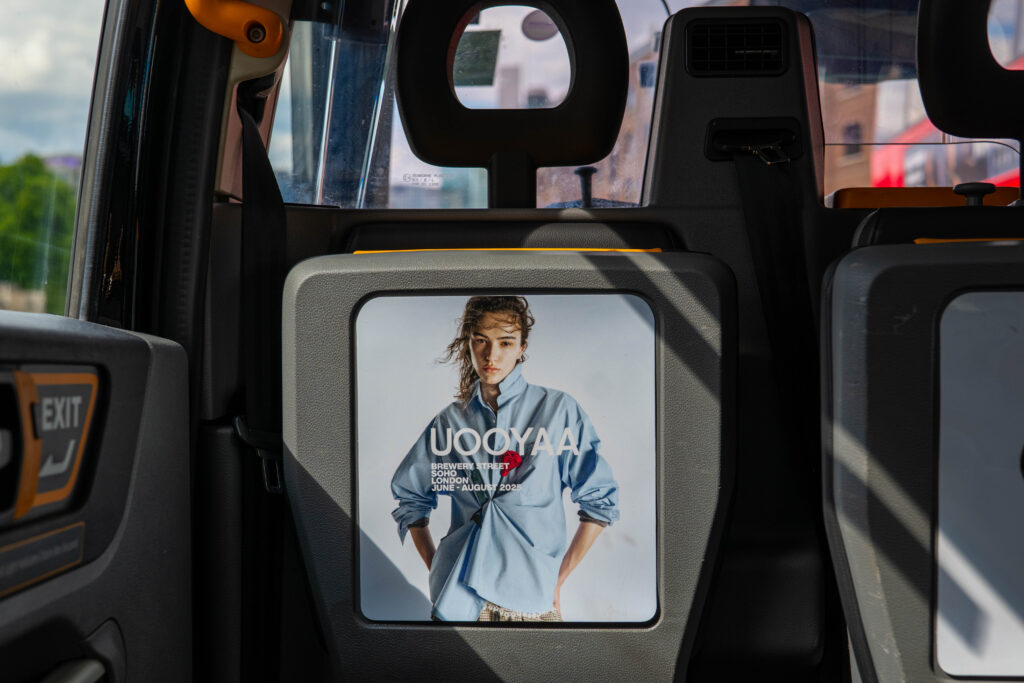
London is a major global capital and one of the most influential hubs for out-of-home (OOH) advertising. With its dense population, multicultural presence, and fast-paced lifestyle, the city provides the perfect environment for impactful London taxi advertising. Among all available OOH formats, taxis stand out as one of the most visible, respected, and widely circulated platforms on the streets of London.
1. A Global Leader in OOH Advertising
London’s outdoor advertising scene is among the most active in the world. From busy intersections to commercial districts, public transport hubs to iconic landmarks, the city offers unmatched opportunities for brands to capture attention. London taxi advertising moves with the city, covering ground that static billboards can’t reach.
Taxis are not restricted to one location. They pass through high-traffic areas, residential neighbourhoods, cultural sites, and business zones throughout the day. This ensures a brand’s visibility is maximised without additional media buying or location targeting.
2. The Power of the Black Cab
The black cab is one of London’s most iconic visual elements. Locals trust it. Tourists recognise it. The vehicle is a means of transport and a symbol of the city. This gives Black Cab marketing a built-in sense of authenticity and prestige that few other ad formats can match.
When a brand chooses a branded London taxi, it benefits from the positive associations already linked to these vehicles. Whether it’s the reliability of licensed drivers or the timeless design of the cab itself, advertising on a black taxi gives a sense of quality and professionalism that elevates the brand.
3. Broad Local and Tourist Reach
London welcomes millions of international visitors every year. At the same time, it’s home to a large, diverse resident population. Taxis in London, England, serve both groups seamlessly. Whether someone is on a sightseeing trip to the Tower of London or heading to a work meeting in Shoreditch, they’re likely to spot multiple taxi ads along the way.
For brands, this means exposure to both high-frequency locals and fresh tourist audiences. It’s a unique advantage that makes London taxi advertising a smart choice for both global brands and local businesses.
4. High-Income Commuter Access
London is also home to some of the highest-income workers in Europe. Professionals across finance, media, tech, law, and healthcare often travel through central zones and airport corridors — areas where taxis are always present.
A branded London taxi in these routes offers brands a chance to get noticed by decision-makers, business owners, and consumers with strong purchasing power. This positions taxi advertising not only as a reach tool, but also as a strategy for targeting premium audiences.
5. Clear Brand Benefits in the London Market
Taxi advertising in London delivers measurable brand benefits:
- Constant visibility in prime locations
- Association with trusted vehicles
- Cross-demographic reach across locals and tourists
- Access to high-value consumer segments
- Consistent presence without ad blockers, skipping, or scrolling
In such a saturated advertising environment, being seen and remembered is everything. Taxis deliver both, making London taxi advertising one of the most effective formats for building long-term brand recognition in the capital.
Taxi Advertising Campaign Strategies
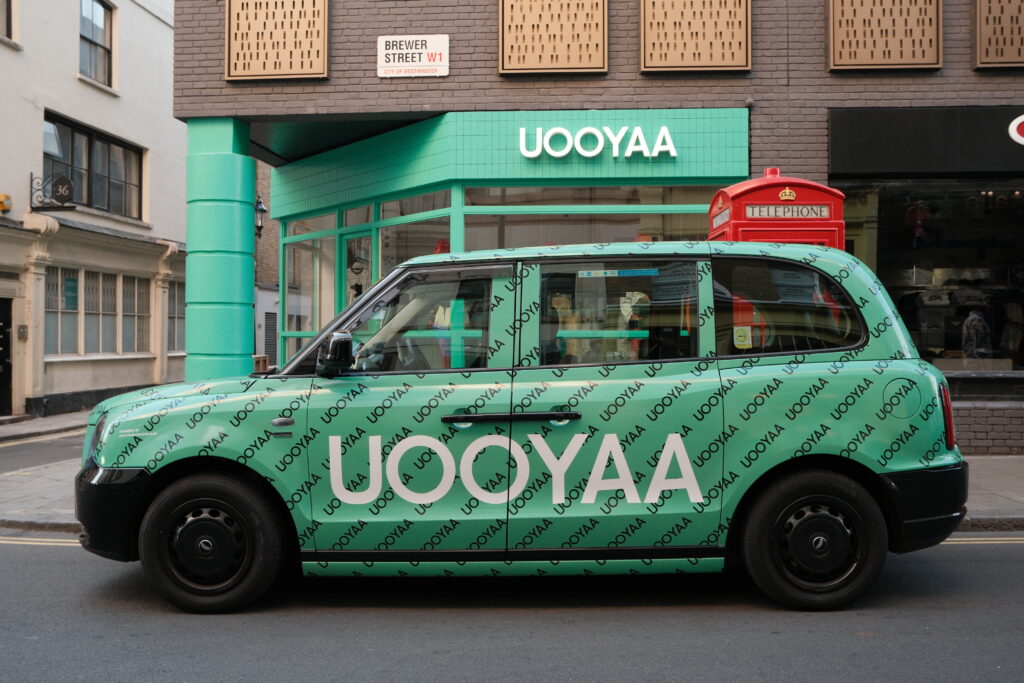
Successful taxi ad campaigns in London rely on more than just eye-catching visuals. To get the best return on investment, brands need to approach taxi advertising with a clear strategy — one that blends creativity with data, audience behaviour, timing, and messaging. Below are key tactical insights for planning and executing effective taxi advertising strategies that stand out on the streets and drive real results.
1. Structuring the Campaign: Creative, Location, Time
Every campaign should begin with a well-defined goal. Are you promoting a new product? Launching a seasonal offer? Building long-term brand awareness? The answer will shape your approach to the creative, location targeting, and campaign duration.
- Creative Design: Use bold, simple visuals that are easy to absorb at a glance. Prioritise brand colours, logos, and short messages that don’t require too much reading time. The best taxi advertising ideas focus on visual clarity and brand consistency.
- Location Coverage: Identify key zones across London that align with your target audience. For example, fashion brands may want coverage around Oxford Street, while tech startups might prefer routes near Shoreditch or Canary Wharf. Fleet advertising lets you scale your presence across diverse areas while maintaining creative consistency.
- Timing: Decide if your campaign should run during specific months, days, or times of day. Commuter hours, lunch breaks, and weekend evenings each offer different exposure opportunities.
2. Leveraging Data, GPS, and Analytics
Modern taxi ad campaigns in London benefit from real-time GPS tracking and performance analytics. Taxi fleets now offer data-driven reports showing which neighbourhoods your cabs passed through, how many impressions were estimated, and what dwell times looked like.
- Use GPS data to map out routes that align with your audience profiles.
- Analyse daily and weekly reports to refine your messaging or targeting strategy.
- Some platforms allow A/B testing of different creatives across the fleet to see which version performs better.
Data-backed fleet advertising ensures your message isn’t just seen — it’s seen by the right people, at the right time, in the right place.
3. Seasonal Strategies and Time-Bound Campaigns
London’s calendar is full of events that offer natural windows for targeted advertising — from Fashion Week to holiday shopping to summer festivals.
- Launch taxi advertising ideas around holidays, back-to-school promotions, or sporting events.
- Use limited-time creatives to drive urgency, such as “This Week Only” or “Visit Before 30th June.”
- Promote location-specific offers, like discounts valid only at stores in the West End or pop-ups at local markets.
Seasonal campaigns work well when paired with taxis because of their constant citywide movement. Your message can quickly reach where the buzz is — and stay there for the duration of your event or promotion.
4. CTA Strategies Inside Cabs
While the exterior of the taxi grabs attention, the interior offers a unique chance to drive action. Tip-seat ads, QR codes, and short-form messaging on side panels or rear windows give passengers time to engage.
- Use QR codes for app downloads, discount offers, or bookings.
- Keep CTAs clear, short, and action-oriented. For example: “Scan to Order Now” or “Get 15% Off Today.”
- Make sure your CTA aligns with the journey time. Passengers stuck in traffic are more likely to engage with content than those on a five-minute ride.
Interior CTAs also offer trackable results. By monitoring QR scans or coupon redemptions, brands can directly measure how effective their taxi ad campaigns in London are.
Taxi Advertising for Events & Local Marketing
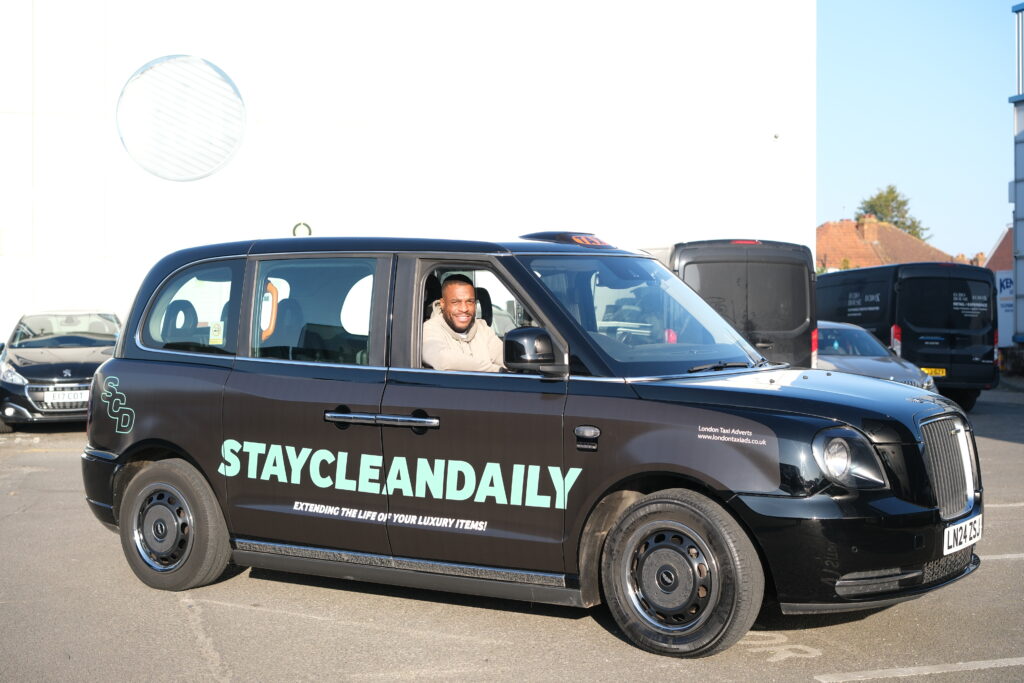
When it comes to high-impact event promotion and targeted outreach, taxi advertising for events in London offers brands a flexible and hyper-local way to create buzz. From product launches to weddings, trade shows, concerts, and cultural festivals, taxis can serve as moving billboards that guide, inform, and engage attendees across the city.
1. Events That Benefit from Taxi Advertising
Taxi advertising is especially effective when promoting:
- Weddings and private celebrations
Branded taxis are a stylish way to escort guests while also creating a visual impression around venues. Couples often use custom taxi wrap advertising to showcase their names, hashtags, or special messages.
- Trade shows and exhibitions
A short-term taxi fleet wrapped in brand visuals can increase footfall at your booth or showroom. Taxis offer 24/7 visibility in the days leading up to and during the event.
- Concerts, sports events, and festivals
Whether you’re promoting a live show at The O2 or a weekend festival in Hyde Park, taxis provide mobile reach to crowds across London long before the event begins.
- Product launches and pop-ups
For new store openings or limited-time campaigns, taxis help brands establish presence in key neighbourhoods while also serving as navigational aids or event ambassadors.
2. Event-Based Targeting and Flexible Fleet Use
One of the biggest advantages of taxi advertising for events in London is flexibility. Brands don’t need long contracts or citywide exposure if their campaign is time-bound.
- Book short-term fleet advertising contracts for a few days or weeks.
- Target taxis to operate in specific postcodes or near event venues.
- Coordinate cab presence at pickup zones, hotels, or transit hubs used by event attendees.
This level of control ensures that your local marketing in London is efficient, visible, and aligned with where your audience is.
3. Engage with Interactive Tools: QR Codes and Event Maps
Taxi ads aren’t just for visibility. They can be designed for interaction.
- Use QR codes on exterior or interior panels to drive event signups, RSVP pages, or ticket purchases.
- Share promo codes for event discounts or giveaways. This adds urgency and trackability.
- Include custom event maps or links to digital guides that help attendees navigate multi-venue events or trade shows.
For example, a festival ad can include a QR code that opens the event schedule, stage map, or food vendor list. A product launch can link directly to a store locator or booking page.
Cost Breakdown: What Influences Taxi Advertising Rates?
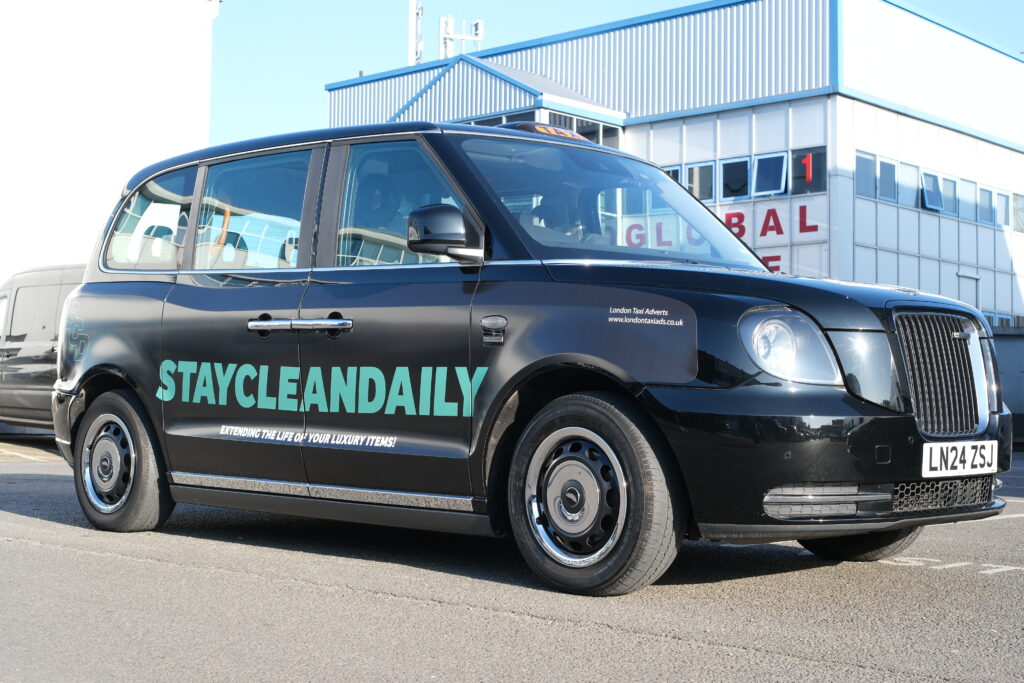
Before launching a campaign, understanding the cost structure behind London taxi advertising is essential. Taxi ads offer flexibility and reach, but pricing can vary depending on a range of factors from fleet size to ad format. Here’s a breakdown of what shapes taxi ad rates and how they compare to other common OOH formats in London.
1. Key Factors That Influence Pricing
Several core elements determine the cost of taxi wraps in London and other taxi ad formats:
- City & Location
In high-traffic cities like London, prices tend to be higher due to increased impressions and premium visibility. Advertising near central zones or iconic landmarks may come at a higher rate.
- Fleet Size
The number of taxis booked for the campaign significantly affects the cost. A small fleet of 5 to 10 cabs offers lower coverage but is more budget-friendly. Larger fleet advertising with 50+ cabs drives more visibility and brand repetition, but will naturally cost more.
- Format Type
Full wraps cost more than partial wraps or top screens. Interior ads are usually the most affordable format.
- Campaign Duration
Short-term campaigns (2 to 4 weeks) have higher rates per week, while longer-term bookings (3 to 6 months) bring down the average weekly cost.
- Creative & Production Costs
Designing, printing, and applying vinyl wraps adds to the total campaign spend. Digital screens require ad formatting, rotation setup, and sometimes programmatic management.
3. Taxi Ads vs. Other OOH Options
Taxi ads offer a unique advantage that is mobility. While billboards and tube posters rely on static placements, taxis move through business districts, shopping areas, and residential zones, delivering repeated impressions.
4. Tracking Performance with Analytics
With the rise of digital reporting tools, taxi advertising analytics now include GPS tracking, estimated impressions, and campaign heatmaps. This allows brands to monitor where their taxis go, how often they pass through target zones, and how performance changes over time.
Taxi Advertising Packages – What’s Offered?
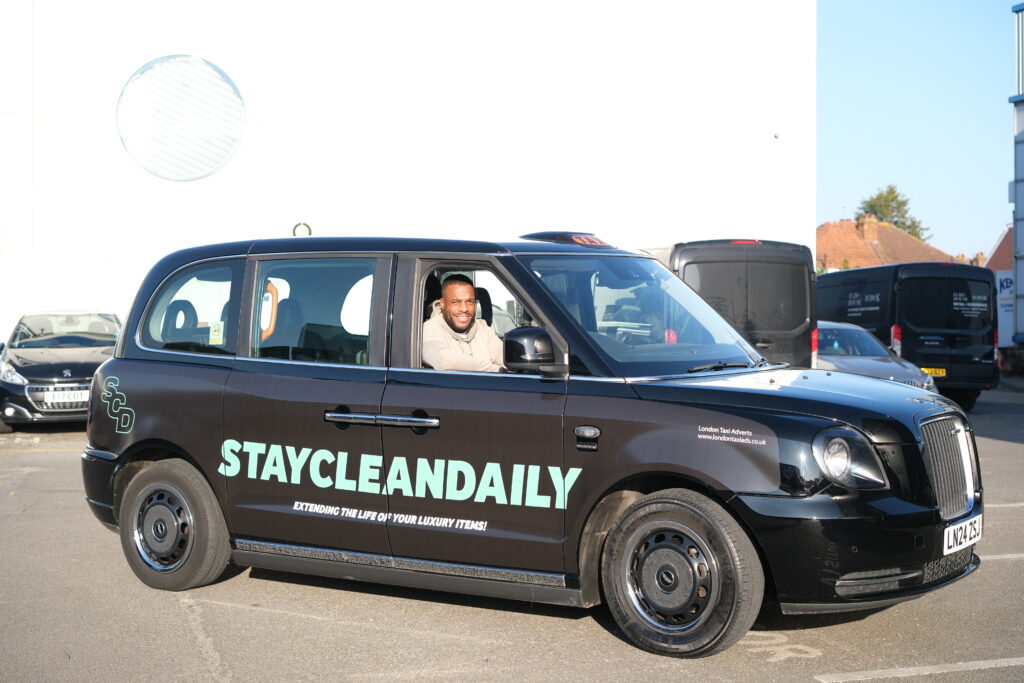
Understanding the different types of London taxi advertising packages can help you choose the right fit for your goals and budget. Most agencies offer a range of service options from full-service campaigns to modular offerings that let brands pick what they need.
1. Common Package Types Offered by Agencies
Agencies that specialize in taxi ad booking typically offer three main categories of packages:
- Full-Service Packages
These include everything: campaign planning, creative design, vinyl printing, taxi wrap application, GPS tracking, and post-campaign analytics. Many also include media buying, compliance with Transport for London (TfL) regulations, and reporting.
- Media-Only Packages
For brands that already have creative assets or work with their own design teams, media-only packages provide access to a taxi ad fleet in London. The agency handles the fleet coordination and ad placements, but doesn’t get involved in the design or wrap production.
- Design-Only or Creative Support Packages
Some agencies offer standalone creative services. This may include designing the taxi wrap, adapting existing campaigns to taxi formats, or creating short-form interior CTAs and QR code layouts.
2. What’s Typically Included?
London taxi advertising packages often bundle the following:
- Fleet Selection and Management
Choose from standard black cabs, electric taxis, or hybrid vehicles. Fleet size can range from 5 to 100+ vehicles, depending on the scale of your campaign.
- Format Choice
Packages may include options like full wraps, superside panels, digital taxi tops, and interior ads.
- Duration Options
Campaign lengths typically range from two weeks to six months. Long-term contracts usually come at discounted rates.
- Installation & Maintenance
Agencies manage the production, application, and maintenance of wraps, ensuring your visuals remain sharp and damage-free.
- Analytics and Reporting
Most full-service packages now include basic taxi advertising analytics, such as GPS tracking, route maps, estimated impressions, and audience coverage.
3. Popular Bundled Offerings in London
In London, bundled packages are often structured around location goals or campaign types. Popular bundles include:
- Central London Blitz
A fleet of 20–30 cabs operating primarily within Zones 1–2. Ideal for high-footfall coverage around business districts and retail hubs.
- Event Boost
Short-term taxi presence around key event venues like ExCeL London or The O2. Designed for taxi ad booking around festivals, launches, or trade shows.
- Tourist Route Visibility
A taxi ad fleet in London is mapped to routes around top attractions, such as Buckingham Palace, the London Eye, and Covent Garden. Great for travel, hospitality, or entertainment brands.
Taxi Advertising for Small & Medium Businesses
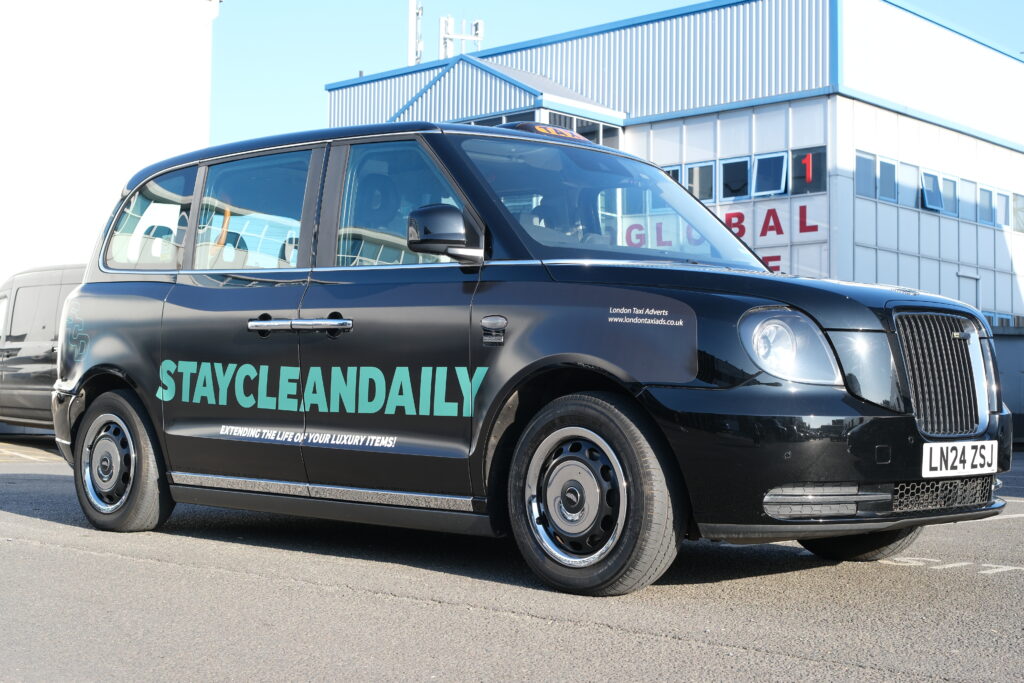
Taxi advertising isn’t reserved for big-budget brands. In fact, it’s an increasingly popular choice among local startups, independent retailers, and service-based companies looking to build presence in high-footfall zones. With the right planning, taxi advertising for small businesses can deliver exceptional value through cost-effective formats and targeted regional exposure.
1. Budget-Friendly Options for SMEs
For businesses working with limited marketing budgets, several affordable formats are available:
- Partial wraps and superside panels offer strong street visibility at a fraction of the cost of a full wrap.
- Interior ads on tip-seats or side panels are great for targeting captive audiences during their ride.
- Booking a small fleet of 3 to 5 taxis for a month or two allows for focused campaigns without overcommitting resources.
Many agencies offer cheap taxi ads in London that are designed for small businesses. These packages typically include design assistance, vinyl application, and limited-time fleet access — all without long-term contracts.
2. Hyperlocal Reach and Targeting
Taxi advertising is ideal for hyperlocal targeting. A bakery in Camden, a dental clinic in Brixton, or a co-working space in Shoreditch can all benefit from using taxis that circulate in their neighborhoods. Unlike static billboards, taxis move through high-traffic areas throughout the day, increasing local visibility.
With smart route planning and postcode-specific targeting, small businesses can maximize taxi advertising reach exactly where it matters among their potential customers in nearby streets, marketplaces, and residential zones.
Innovations & Trends in Taxi Advertising
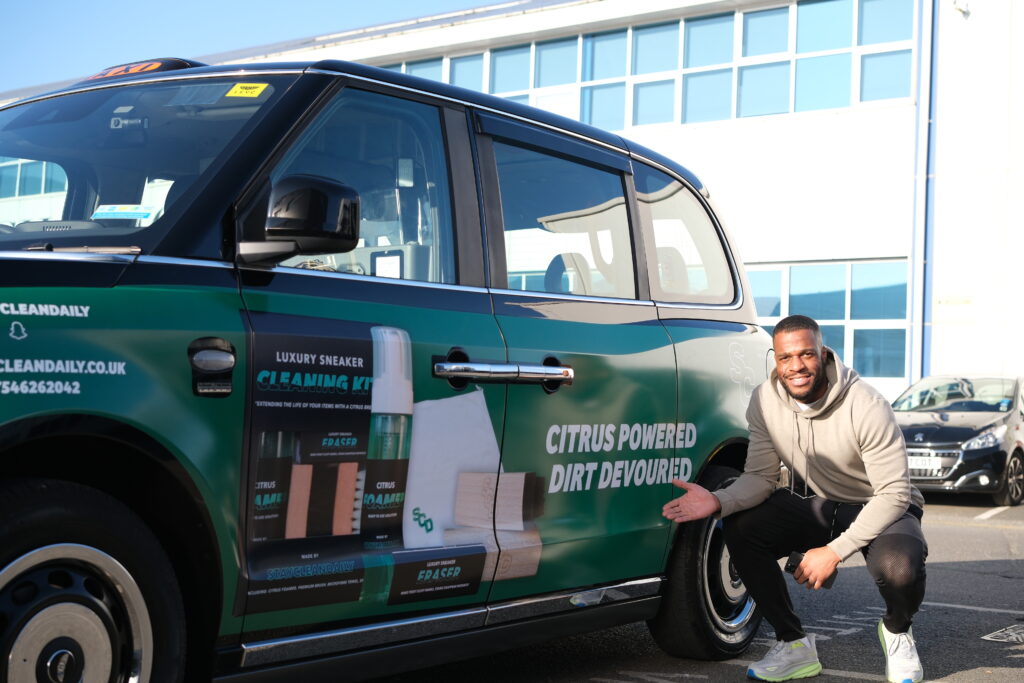
The world of taxi advertising is evolving rapidly, with new technologies making campaigns smarter, more targeted, and more sustainable. For brands aiming to stay ahead of the curve, adopting innovative taxi advertising strategies can lead to better audience engagement and a stronger return on investment.
1. Real-Time GPS-Based Targeting
One of the biggest breakthroughs in mobile taxi ad campaigns is the use of GPS for dynamic targeting. Advertisers can now track where their branded taxis are going in real time and optimize routes based on audience density, time of day, or campaign goals.
Taxis can be programmed to operate near retail zones, business hubs, or event venues. GPS data offers heatmaps of impressions and dwell times, helping marketers refine future campaigns.
2. Programmatic Fleet Advertising
Borrowing from the world of digital marketing, programmatic taxi advertising allows brands to schedule, launch, and modify campaigns remotely across a fleet.
- Ads can be rotated by time, location, or even weather conditions.
- Multiple creatives can be tested and swapped without reprinting materials.
- It brings agility to an otherwise static medium, offering brands control and speed.
This tech-driven approach has made digital taxi advertising a popular option for campaigns that require high responsiveness or data-driven refinement.
3. AI-Powered Ad Scheduling
Artificial intelligence now plays a growing role in taxi ad management. AI tools analyze traffic patterns, rider behavior, and past performance to suggest the best ad rotation schedule for maximum exposure.
- Ads can be scheduled to appear during peak commuter hours or event timings.
- AI models learn which neighborhoods produce the best recall and click-through rates from previous campaigns.
For brands looking to optimize their mobile taxi ad campaigns, AI offers a way to automate decision-making without sacrificing performance.
4. Eco-Friendly Taxi Wraps
As sustainability becomes a priority, brands are also looking at eco-friendly taxi wrap advertising. Many London agencies now offer biodegradable or recyclable wrap materials, along with electric or hybrid taxi fleets.
- These green options reduce the carbon footprint of your campaign.
- Consumers are increasingly responsive to brands that prioritize sustainability in their advertising efforts.
With rising environmental awareness, incorporating eco-friendly taxi wrap advertising into your strategy is responsible for effective branding.
Choosing the Right Taxi Advertising Company in London
Finding the right London taxi advertising company is crucial to campaign success. With so many options available, knowing what to look for can save time, money, and effort.
1. What to Look For?
A reliable agency should offer:
- Transparent pricing and detailed deliverables
- Strong design support for wraps and CTAs
- Campaign reporting with GPS analytics and reach data
- Compliance with Transport for London (TfL) regulations
Look for agencies that treat your campaign like a partnership, not just a transaction. Experience in outdoor advertising in London matters, especially when targeting competitive city zones.
2. Top Companies to Explore
While we won’t list specific agencies here, most of the best taxi advertising companies in London offer full-service packages, creative design, programmatic tools, and real-time analytics. Some also specialize in short-term bookings for events or SMEs. Do your research, check client reviews, and ask for case studies before committing.
3. Questions to Ask Before Booking
- Do you offer GPS tracking and campaign analytics?
- Can I choose specific taxi routes or zones?
- What is your experience with my industry?
- Are there any hidden fees in production or wrap removal?
- Do you provide creative support or just media booking?
A well-informed decision ensures your campaign runs smoothly and makes the most of your taxi advertising media investment.
Measuring Success: Taxi Advertising Metrics & ROI
To ensure your campaign delivers results, it’s essential to measure its effectiveness using clear metrics. Today’s taxi campaigns are no longer guesswork. Thanks to modern tools, brands can now track performance through taxi advertising statistics and GPS-based reporting systems.
Key Performance Indicators (KPIs)
The most commonly tracked KPIs include:
- Impressions: The estimated number of people who see your ad daily or weekly, based on fleet routes and traffic density.
- Reach: How far your campaign spreads across different parts of the city.
- QR code scans: Direct engagement data from passengers or pedestrians.
- Engagement time: How long users view your interior ads or interactive content.
These metrics are collected through tracking platforms, QR analytics, and consumer behavior reports.
Using GPS and Heatmaps
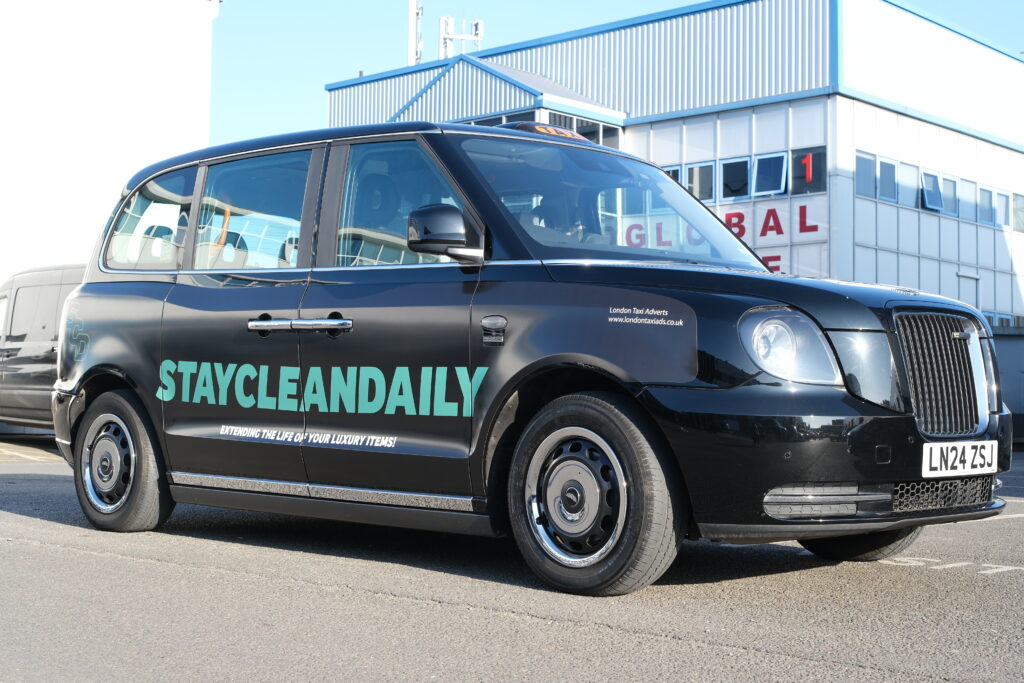
Many campaigns now come with GPS tracking and heatmaps to visually show where your taxis traveled and where your ads gained the most exposure. This allows marketers to adjust routes in real time and double down on high-performing areas.
1. Comparing ROI Across Formats
When it comes to return on investment, taxi advertising ROI is highly competitive compared to other outdoor formats. Brands typically pay less per impression than with digital billboards or bus ads, especially when considering 24/7 mobility and broader audience reach.
In the context of the broader London advertisement campaign ROI, taxis offer long-term visibility with built-in trust and flexibility. For small and large brands alike, this translates to a cost-effective way to maintain presence and relevance on the streets.
Why Taxi Advertising Still Drives Results?
Advertising on taxis with wraps remains one of the most powerful tools in outdoor marketing. It combines motion, visibility, and trust in a format that feels integrated into city life rather than imposed on it.
London’s streets are alive with movement, and taxis are at the heart of it. A well-executed taxi advert has the ability to capture attention from every direction. It reaches commuters, tourists, and shoppers in real time. It makes your message mobile, memorable, and impossible to scroll past.
Success in advertising in London comes down to three core principles: the right format, the right timing, and the right location. Whether you’re aiming for brand awareness, app downloads, or event attendance, taxis can put your message in front of the people who matter most.
FAQs
1. Can I advertise on a single taxi or a small fleet?
Yes. Most agencies offer flexible taxi ad booking options, including campaigns with just 1 to 5 taxis. This is ideal for local businesses or event-based promotions looking for controlled exposure.
2. Are taxi wraps removable?
Absolutely. Taxi wraps are designed to be temporary and non-damaging. They are applied using professional vinyl and can be removed or replaced without harming the vehicle’s surface.
3. Can I track my ad’s performance?
Yes. Through taxi advertising analytics, you can track GPS routes, impressions, QR code scans, and reach. Some agencies also provide weekly reports and heatmaps to evaluate performance in real time.
4. What are the most efficient taxi ad formats?
For maximum brand visibility, full wraps offer the highest impact. However, digital tops and tip-seat interior ads are excellent for engagement and cost efficiency. The best format depends on your budget, audience, and campaign goals.
